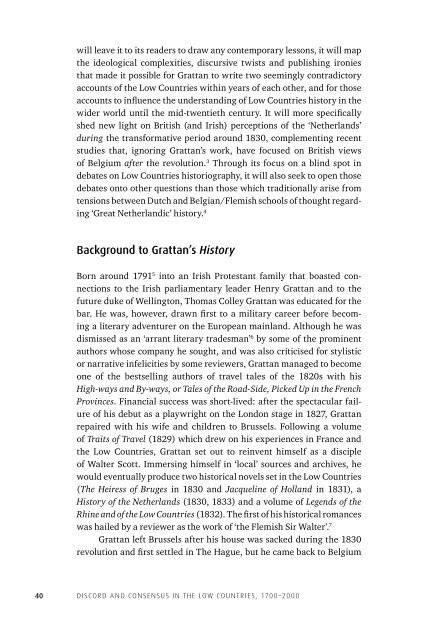Discord Consensus
7aze300jFJo
7aze300jFJo
Create successful ePaper yourself
Turn your PDF publications into a flip-book with our unique Google optimized e-Paper software.
will leave it to its readers to draw any contemporary lessons, it will map<br />
the ideological complexities, discursive twists and publishing ironies<br />
that made it possible for Grattan to write two seemingly contradictory<br />
accounts of the Low Countries within years of each other, and for those<br />
accounts to influence the understanding of Low Countries history in the<br />
wider world until the mid-twentieth century. It will more specifically<br />
shed new light on British (and Irish) perceptions of the ‘Netherlands’<br />
during the transformative period around 1830, complementing recent<br />
studies that, ignoring Grattan’s work, have focused on British views<br />
of Belgium after the revolution. 3 Through its focus on a blind spot in<br />
debates on Low Countries historiography, it will also seek to open those<br />
debates onto other questions than those which traditionally arise from<br />
tensions between Dutch and Belgian/Flemish schools of thought regarding<br />
‘Great Netherlandic’ history. 4<br />
Background to Grattan’s History<br />
Born around 1791 5 into an Irish Protestant family that boasted connections<br />
to the Irish parliamentary leader Henry Grattan and to the<br />
future duke of Wellington, Thomas Colley Grattan was educated for the<br />
bar. He was, however, drawn first to a military career before becoming<br />
a literary adventurer on the European mainland. Although he was<br />
dismissed as an ‘arrant literary tradesman’ 6 by some of the prominent<br />
authors whose company he sought, and was also criticised for stylistic<br />
or narrative infelicities by some reviewers, Grattan managed to become<br />
one of the bestselling authors of travel tales of the 1820s with his<br />
High-ways and By-ways, or Tales of the Road-Side, Picked Up in the French<br />
Provinces. Financial success was short-lived: after the spectacular failure<br />
of his debut as a playwright on the London stage in 1827, Grattan<br />
repaired with his wife and children to Brussels. Following a volume<br />
of Traits of Travel (1829) which drew on his experiences in France and<br />
the Low Countries, Grattan set out to reinvent himself as a disciple<br />
of Walter Scott. Immersing himself in ‘local’ sources and archives, he<br />
would eventually produce two historical novels set in the Low Countries<br />
(The Heiress of Bruges in 1830 and Jacqueline of Holland in 1831), a<br />
History of the Netherlands (1830, 1833) and a volume of Legends of the<br />
Rhine and of the Low Countries (1832). The first of his historical romances<br />
was hailed by a reviewer as the work of ‘the Flemish Sir Walter’. 7<br />
Grattan left Brussels after his house was sacked during the 1830<br />
revolution and first settled in The Hague, but he came back to Belgium<br />
40<br />
DISCORD AND CONSENSUS IN THE LOW COUNTRIES, 1700–2000


